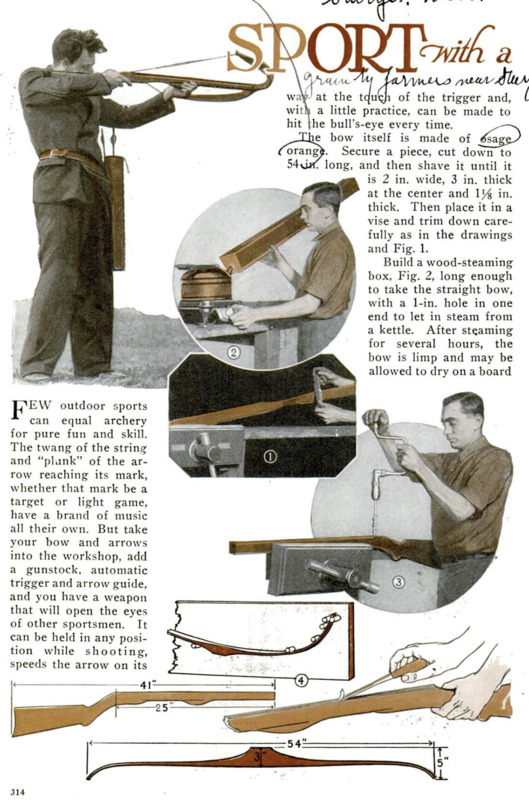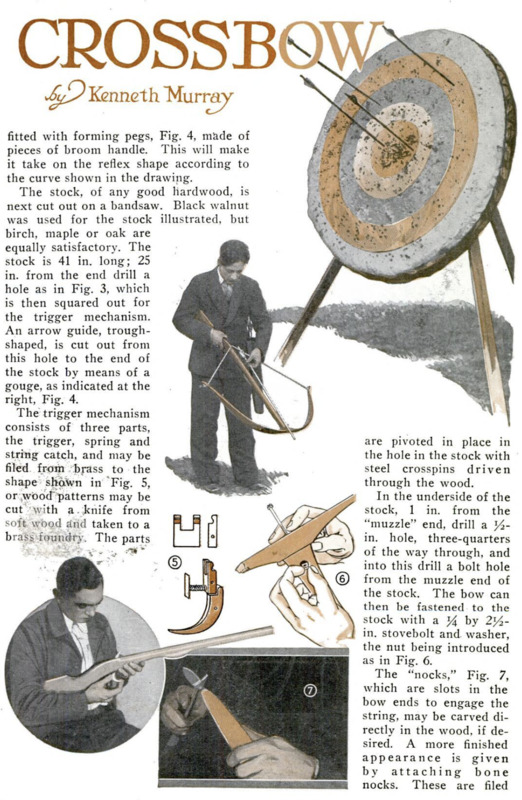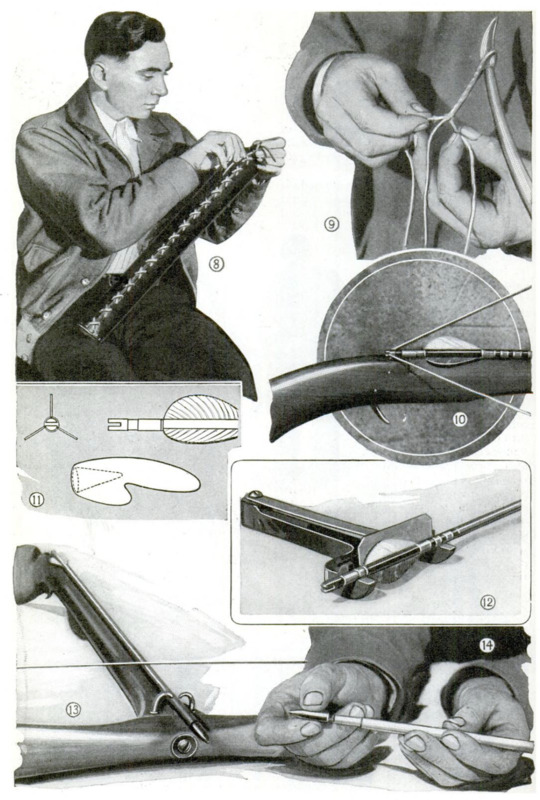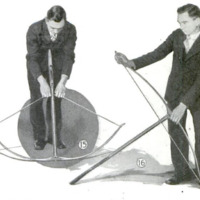-
Title (Dublin Core)
-
Sport with a Crossbow
-
Article Title and/or Image Caption (Dublin Core)
-
Sport with a Crossbow
-
extracted text (Extract Text)
-
FEW outdoor sports can equal archery for pure fun and skill. The twang of the string and "plank" of the arrow reaching its mark, whether that mark be a target Or light game, have a brand of music all their own. But take your bow and arrows into the workshop, add a gunstock, automatic trigger and arrow guide, and you have a weapon that will open the eyes of other sportsmen. It can be held in any position while shooting, speeds the arrow on its way at the touch of the trigger and, with a little practice, can be made to hit the bull's-eye every time. The bow itself is made of osage orange. Secure a piece, cut down to 54un. long, and then shave it until it
is 2 in. wide, 3 in. thick at the center and 1⅛ in. thick. Then place it in a vise and trim down carefully as in the drawings and Fig. 1. Build a wood-steaming box, Fig. 2, long enough to take the straight bow, with a 1-in. hole in one end to let in steam from a kettle. After steaming for several hours, the bow is limp and may be allowed to dry on a board fitted with forming pegs, Fig. 4, made of pieces of broom handle. This will make it take on the reflex shape according to the curve shown in the drawing. The stock, of any good hardwood, is next cut out on a bandsaw. Black walnut was used for the stock illustrated, but birch, maple or oak are equally satisfactory. The stock is 41 in. long; 25 in. from the end drill a hole as in Fig. 3, which is then squared out for the trigger mechanism. An arrow guide, trough-shaped, is cut out from this hole to the end of the stock by means of a gouge, as indicated at the right, Fig. 4. The trigger mechanism consists of three parts, the trigger, spring and string catch, and may be filed. from brass to the shape shown in Fig. 5, or wood patterns may be cut with a. knife from soft wood and taken to a brass foundry. The parts are pivoted in place in the hole in the stock with steel crosspins driven through the wood. In the underside of the stock, 1 in. from the "muzzle" end, drill a ½-hole, three-quarters of the way through, and into this drill a bolt hole from the muzzle end of the stock. The bow can then be fastened to the stock with a ¼ by 2½-in. stovebolt and washer, the nut being introduced as in Fig. 6. The "nocks," Fig. which are slots in the bow ends to engage the string, may be carved directly in the wood, if de-sired. A more finished appearance is given by attaching bone nocks. These are filed down from pieces of cow-horn to the shape shown in Fig. 11. They may be polished with pumice and fitted tightly to the bow ends by friction. Waxed Trish-linen cord is used for the string, braided from three strands, as in
Fig. 9. The arrows are 28 in. long and made of birch doweling. The points are trimmed down to take an empty cartridge shell, Fig. 14, which is dented in the side with a punch to make it hold securely. Turkey feathers are split with a razor blade and trimmed for feathering, which may be done with a clamp like the one illustrated in Fig. 12, or with a homemade wood vise. Use a good waterproof glue, and the feathers will hold securely. They may be dyed any color desired before attaching. A convenient quiver or carrying case (Fig. 8) can be made from a piece of cow-hide, 22 in. long by 9 in. wide, joined with thongs of the same material on the side and having as a bottom a round wood disk tacked in place. Figure 10 shows the arrow in position on the bow ready for a pull of the trigger. To hold the arrows securely on the stock while shooting, flatten the ends of two short pieces of brass rod, bend them over and insert in the end of the stock, as shown in Fig. 13. They should barely touch the arrow and are positioned so as to allow the feathers to pass freely. After stringing up the bow, Fig. 16, you are ready to try it for strength. With infinite caution gradually bring the string up to the trigger catch, as in Fig. 15. On the pull necessary depends the strength of the gun, and the bending of the bow must be done gradually in order to "break it in' without splintering. If found too stiff, it should be shaved down gradually, trying it each time. When at last the bow is of the right strength (and it should give stiff resistance), an arrow may be inserted for trial. Such is. the speed of the bow gun that the pulling of the trigger and arrow striking the target, appear simultaneous. Never pull the trigger without an arrow in the gun, as the string will snap in two. The bow gun may now be finished by staining the stock and varnishing both stock and bow. A suitable target is made from hay or straw board with cords and covered with white oilcloth on which the bull's-eye is painted.
In shooting the bow gun, it is not difficult to secure perfect aim every time, and with considerable practice one learns to allow for "windage," that is, the strength of the wind throwing the arrow off its course. This is much less than with the ordinary bow and arrow, however, as the bow gun is tremendously powerful, and, due to its speed, the arrow is less affected by wind and gravity than otherwise. The usual precautions should be observed while on "shoots." The gun is perfectly harmless without an arrow in it, so the arrow should never be inserted until each shot. Practically any kind of small or large game may be hunted and, because of the accuracy with which the gun sends the arrow on its way, misses will be found few and far between.
-
Contributor (Dublin Core)
-
Kenneth Murray (writer)
-
Language (Dublin Core)
-
eng
-
Date Issued (Dublin Core)
-
1930-08
-
pages (Bibliographic Ontology)
-
314-317
-
Rights (Dublin Core)
-
Public Domain (Google digitized)
-
Archived by (Dublin Core)
-
Alberto Bordignon
 Popular Mechanics, v. 54, n. 2, 1930
Popular Mechanics, v. 54, n. 2, 1930








